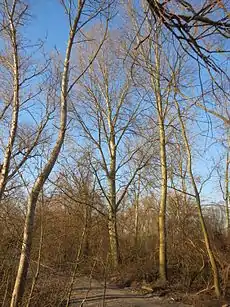Parasyrphus nigritarsis
Parasyrphus nigritarsis is a species of Hoverfly, from the family Syrphidae, in the order Diptera.[1][2]
| Parasyrphus nigritarsis | |
|---|---|
| Scientific classification | |
| Kingdom: | |
| Phylum: | |
| Class: | |
| Order: | |
| Family: | |
| Subfamily: | |
| Tribe: | |
| Genus: | |
| Species: | P. nigritarsis |
| Binomial name | |
| Parasyrphus nigritarsis (Zetterstedt, 1843) | |
| Synonyms[1] | |
| |
Description
External images
For terms, see: Morphology of Diptera
Wing length: 9–11.5 mm (0.35–0.45 in). Tergites 3 and 4 have a marginal sulcus. Femur 3 is entirely yellow or apical 1/4 yellow. Face is without black stripe, but with black mouth edge. Female frons has large dust patches. The male genitalia are figured by Hippa (1968).[3] Larva described and figured by Rotheray (1994).[4]
Distribution
Palearctic: Fennoscandia South to Belgium and North Spain, Ireland east through Central Europe into Russia and on to the Russian Far East and the Pacific coast, including Japan. Nearctic: Alaska to Quebec and south to Washington and Idaho.[9][10][11]

Biology
Habitat: Alnus, Salix, Populus tremula woodland and wetland and Alnus viridis scrub up to 2,000 metres (6,600 ft) in the Alps.[12] Flowers visited include Anemone nemorosa, Potentilla erecta, Prunus cerasus, Prunus spinosus, Ranunculus, Rhododendron aureum, Rubus idaeus, Salix.[13] The flight period is end May to end June. The larva is predatory on the larvae of chrysomelid beetles on trees and shrubs.
References
- Chandler, Peter J. (1998). Checklists of Insects of the British Isles (New Series) Part 1: Diptera. Handbooks for the Identification of British Insects. New Series. 12. London: Royal Entomological Society of London. pp. 1–234. ISBN 0-901546-82-8.
- Stubbs, Alan E. & Falk, Steven J. (1983). British Hoverflies: An Illustrated Identification Guide. British Entomological & Natural History Society. pp. 253, xvpp.
- Hippa, H. (1968) A generic revision of the genus Syrphus and allied genera (Diptera: Syrphidae) in the Palearctic region, with descriptions of the male genitalia. Acta Ent.Fenn., 25: 1-94.
- Rotheray G., 1993 Colour Guide to Hoverfly Larvae Diptera, Syrphidae in Britain and Europe Dipterists Forum pdf
- Van Veen, M. (2004). Hoverflies of Northwest Europe: identification keys to the Syrphidae. 256pp. KNNV Publishing, Utrecht.addendum
- Van der Goot, V.S. (1981). De zweefvliegen van Noordwest - Europa en Europees Rusland, in het bijzonder van de Benelux. KNNV, Uitgave no. 32: 275pp. Amsterdam.
- Bei-Bienko, G.Y. & Steyskal, G.C. (1988). Keys to the Insects of the European Part of the USSR, Volume V: Diptera and Siphonaptera, Part I. Amerind Publishing Co., New Delhi. ISBN 81-205-0080-6.
- Coe, R.L. (1953). "Diptera: Syrphidae". Handbks. ident. Br. insects 10(1): 1-98. R .ent. Soc. London. pdf
- Fauna Europaea
- Peck, L.V. (1988) Syrphidae. In: Soos, A. & Papp, L. (eds.) Catalogue of Palaearctic Diptera, 8: 11-230. Akad.Kiado, Budapest.
- Vockeroth, J.R. (1992). The Flower Flies of the Subfamily Syrphinae of Canada, Alaska, and Greenland (Diptera: Syrphidae). Part 18. The Insects and Arachnids of Canada. Ottawa, Ontario: Canadian Government Pub Centre. pp. 1–456. ISBN 0-660-13830-1.
- Speight, M.C.D. (2011). "Species accounts of European Syrphidae (Diptera)" (PDF). Syrph the Net, the Database of European Syrphidae. 65: 285pp.
- de Buck, N. (1990). "Bloembezoek en bestuivingsecologie van Zweefvliegen (Diptera, Syrphidae) in het bijzonder voor België". Doc. Trav. IRSNB, no. 60, pp. 1-167.
